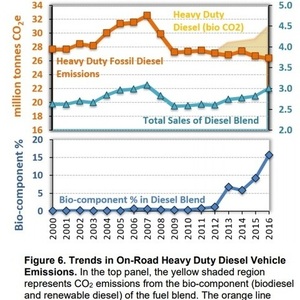Biodiesel helps push California GHG emissions below 1990 levels

Source: California Air Resources Board
July 17, 2018
BY Erin Krueger
The California Air Resources Board has announced that in 2016 the state’s greenhouse gas (GHG) emissions fell below 1990 levels for the first time since emissions peaked in 2004. Biofuels helped achieve the reduction.
Assembly Bill 32, legislation passed in California in 2006, requires the state to reduce its emissions to 1990 levels, or 431 million metric tons, by 2020. The 2016 Greenhouse Gas Emissions Inventory published July 11 shows California emitted 429 million metric tons of climate pollutants in 2016, a 3 percent drop when compared to 2015. Senate Bill 32, signed in 2016, requires the state to continue reducing GHG emissions, cutting emissions to 40 percent below 1990 levels by 2030.
According to the 2016 inventory published by CARB, carbon pollution dropped 13 percent statewide since 2004, while California’s economy grew 26 percent. Per capita emissions fell 23 percent from 2001 to 2016 and carbon pollution fell 3 percent from 2015 to 2016. The carbon intensity of California’s economy, which is the amount of carbon pollution emitted per $1 million of gross state product, dropped 38 percent between 2001 and 2016 and is now one-half of the national average.
Advertisement
Advertisement
The transportation sector was the largest source of GHG emissions in California during 2016, accounting for approximately 36 percent of California’s GHG inventory. Emissions from the sector increased 2 percent from 2015 to 2016 due to increased fuel consumption. However, CARB noted that the state also saw cars and trucks use a record 1.5 billion gallons of biofuels in 2016 under the state’s Low Carbon Fuel Standard, accounting for approximately 10 percent of the transportation fuel supply in the state. These low-carbon fuels, consisting primarily of ethanol, biodiesel and renewable diesel, avoided 14 million metric tons of carbon dioxide during the year.
CARB noted that the use of biodiesel and renewable diesel have shown tremendous growth in recent years, going from 1 percent of the total diesel blend in 2012 to 15 percent in 2016. According to the inventory, the continuously increasing market penetration of biodiesel and renewable diesel was able to offset the increase in on-road heavy-duty diesel use.
Advertisement
Advertisement
Related Stories
The U.S. EPA on July 8 hosted virtual public hearing to gather input on the agency’s recently released proposed rule to set 2026 and 2027 RFS RVOs. Members of the biofuel industry were among those to offer testimony during the event.
The USDA’s Risk Management Agency is implementing multiple changes to the Camelina pilot insurance program for the 2026 and succeeding crop years. The changes will expand coverage options and provide greater flexibility for producers.
President Trump on July 4 signed the “One Big Beautiful Bill Act.” The legislation extends and updates the 45Z credit and revives a tax credit benefiting small biodiesel producers but repeals several other bioenergy-related tax incentives.
CARB on June 27 announced amendments to the state’s LCFS regulations will take effect beginning on July 1. The amended regulations were approved by the agency in November 2024, but implementation was delayed due to regulatory clarity issues.
SAF Magazine and the Commercial Aviation Alternative Fuels Initiative announced the preliminary agenda for the North American SAF Conference and Expo, being held Sept. 22-24 at the Minneapolis Convention Center in Minneapolis, Minnesota.
Upcoming Events










